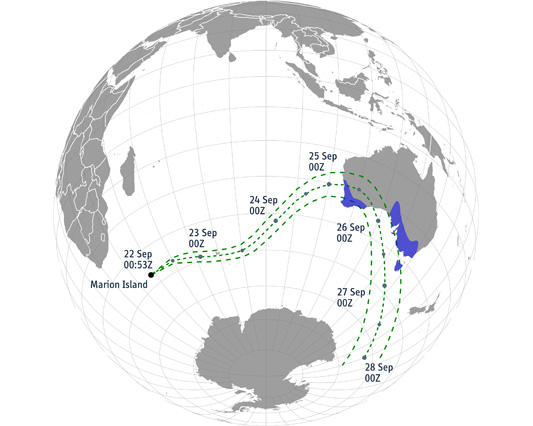 This issue of the journal carries two articles on remote detection of nuclear activities, one looking backwards and the other looking forward. The first article is a forensic analysis of radionuclide and hydroacoustic data that seeks to clarify the long running debate about a possible undeclared nuclear weapon test in in 1979 in the South Atlantic or Indian Ocean (the Vela event). The second article is a scoping study that looks forward to assess the feasibility of using fixed monitoring stations or random air sampling from drones for remote detection of clandestine plutonium separation, with a focus on the Middle East.
This issue of the journal carries two articles on remote detection of nuclear activities, one looking backwards and the other looking forward. The first article is a forensic analysis of radionuclide and hydroacoustic data that seeks to clarify the long running debate about a possible undeclared nuclear weapon test in in 1979 in the South Atlantic or Indian Ocean (the Vela event). The second article is a scoping study that looks forward to assess the feasibility of using fixed monitoring stations or random air sampling from drones for remote detection of clandestine plutonium separation, with a focus on the Middle East.
In "The 22 September 1979 Vela Incident: Radionuclide and Hydroacoustic Evidence for a Nuclear Explosion," Lars-Erik De Geer and Christopher Wright provide the second part of their analysis of records that support a low-yield nuclear weapon test as an explanation for the optical signals detected by a U.S. satellite. Their first article, "The 22 September 1979 Vela Incident: The Detected Double-Flash," was published in this journal in 2017.
The new article offers an analysis of iodine-131, a fission product with a half-life of about 8 days, detected in October and November 1979 in sheep thyroids from southeast Australia. The sheep thyroid data was discovered at the U.S. National Nuclear Testing Archive in Las Vegas. The iodine-131 detection is shown to be consistent with the trajectory of a radioactive cloud from a possible near surface nuclear explosion at sea close to Prince Edward and Marion Islands (46°53′19″S, 37°44′08″E) between South Africa and Antarctica early on 22 September 1979 that would have passed over southern Australia a few days later and rained out.
The article also revisits hydroacoustic evidence from 22 September collected by three hydrophones near Ascension Island in the Atlantic Ocean (between West Africa and Brazil) by the U.S. Missile Impact Location System, and analyzed by the U.S. Naval Research Laboratory in a 300-page report that remains classified, but parts of which has been summarized in a declassified letter from the Naval Research Laboratory Research Director to the White House Office of Science and Technology Policy in December 1980. A second signal was also observed by the U.S. Navy's underwater Sound Surveillance System at a site in Newfoundland. These signals, which can be traced back to a site near Prince Edward and Marion Islands, appear similar to those observed from French nuclear weapon tests in the Pacific Ocean.
The radionuclide and hydroacoustic data appear to have a common source in space and time, one that is consistent with the timing and inferred location of the signal detected by the Vela satellite on 22 September 1979, and together support a nuclear explosion as the explanation. The two articles revisiting the Vela event make a compelling case for declassification of all available records and information concerning this now nearly forty-year old mystery to support a comprehensive, technical, joint international review to determine if, on balance, it was in fact a nuclear weapon test and if so, to attribute responsibility.
The second article in this issue is "Detecting Clandestine Reprocessing Activities in the Middle East" by Michael Schoeppner. It has long been accepted that an international ban on fissile material production for nuclear weapons would require a verification regime that involved monitoring for unauthorized plutonium separation (reprocessing). This article uses a case study of the Middle East to show how monitoring for reprocessing using remote detection of the fission-product krypton-85 released as spent nuclear fuel would be made more difficult by the accumulated concentration of krypton-85 already in the atmosphere. The current krypton-85 atmospheric background is primarily a combination of legacy emissions from the U.S. and the Soviet nuclear weapon programs and active large-scale civilian reprocessing in Britain (Sellafield) and France (La Hague). Krypton-85 lingers in the atmosphere since it is chemically inert and has a 10.8 year half-life.
The article explores four scenarios to assess and demonstrate the verification benefits of ceasing krypton-85 emissions from current declared reprocessing facilities. In the short term, the short-lived peaks in local krypton-85 concentration due to transient plumes from the large operational civilian reprocessing plants would dissipate within days. The overall krypton-85 background would start to decay on a timescale set by the decade-long half-life of krypton-85. Over the long term, 10 years and 30 years respectively after a reprocessing halt, there would be increasing gains in detectability of clandestine reprocessing as the legacy krypton-85 begins to clear out of the atmosphere.
The Middle East is used as a case study for these scenarios. Atmospheric transport models are used evaluate the area over which different rates of krypton-85 emissions from clandestine reprocessing could be detected. The analysis finds that Israel's reprocessing plant at Dimona could be monitored easily using either fixed krypton-85 detectors or airborne sampling. Monitoring larger areas for the absence of reprocessing activities would require random air sampling using aircraft or drones. The article concludes that ending krypton-85 emissions from La Hague and Sellafield would over time drastically reduce the necessary number of random air samples required to monitor the Middle East (and by implication other areas of the world) and that smaller and smaller scale reprocessing activities would become increasingly easy to detect.
